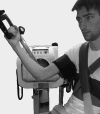FUNCTIONAL OUTCOMES AFTER DISTAL BICEPS BRACHII REPAIR: A CASE SERIES
- PMID: 27904798
- PMCID: PMC5095948
FUNCTIONAL OUTCOMES AFTER DISTAL BICEPS BRACHII REPAIR: A CASE SERIES
Abstract
Objectives: To investigate outcomes after surgical repair of distal biceps tendon rupture and the influence of arm dominance on isokinetic flexion and supination results.
Background/purpose: While relatively uncommon, rupture of the distal biceps tendon can result in significant strength deficits, for which surgical repair is recommended. The purpose of this study was to assess patient reported functional outcomes and muscle performance following surgery.
Methods: A sample of 23 participants (22 males, 1 female), who had previously undergone surgical repair of the distal biceps tendon, were re-examined at a minimum of one year after surgery. Biodex isokinetic elbow flexion and supination testing was performed to assess strength (as measured by peak torque) and endurance (as measured by total work and work fatigue). The Quick Disabilities of the Arm, Shoulder and Hand (QuickDASH) and Mayo Elbow Performance Scale (MEPS) were used to assess participants' subjectively reported functional recovery.
Results: At a mean of 7.6 years after surgical repair, there were no differences between the repaired and uninvolved elbows in peak torque (p = 0.47) or total work (p = 0.60) for flexion or supination. There was also no difference in elbow flexion work fatigue (p = 0.22). However, there was significantly less work fatigue in supination, which was likely influenced by arm dominance, as most repairs were to the dominant arm, F(1,22)=5.67, p = 0.03.
Conclusion: The long-term strength of the repaired elbow was similar to the uninvolved elbow after surgery to the distal biceps tendon. Endurance of the repaired elbow was similar in flexion but greater in supination, probably influenced by arm dominance.
Study design: Retrospective case series.
Level of evidence: Level 4.
Keywords: Elbow; endurance testing; flexion; strength testing; supination.
Figures



Similar articles
-
Elbow strength and endurance in patients with a ruptured distal biceps tendon.J Shoulder Elbow Surg. 2010 Mar;19(2):184-9. doi: 10.1016/j.jse.2009.06.001. Epub 2009 Aug 6. J Shoulder Elbow Surg. 2010. PMID: 19664936
-
Distal biceps tendon rupture: current concepts.Injury. 2013 Apr;44(4):417-20. doi: 10.1016/j.injury.2012.10.029. Epub 2012 Nov 27. Injury. 2013. PMID: 23199755
-
Suture anchor reinsertions of distal biceps rupture: a histologic analysis of a torn tendon and clinical results at short- and long-term follow-up.J Shoulder Elbow Surg. 2021 Feb;30(2):352-358. doi: 10.1016/j.jse.2020.06.025. Epub 2020 Jul 7. J Shoulder Elbow Surg. 2021. PMID: 32650085
-
Operative Versus Nonoperative Management for Distal Biceps Brachii Tendon Lesions: A Systematic Review and Meta-analysis.Orthop J Sports Med. 2021 Oct 29;9(10):23259671211037311. doi: 10.1177/23259671211037311. eCollection 2021 Oct. Orthop J Sports Med. 2021. PMID: 34734095 Free PMC article. Review.
-
Biceps brachii tendon ruptures: a review of diagnosis and treatment of proximal and distal biceps tendon ruptures.Phys Sportsmed. 2010 Jun;38(2):117-25. doi: 10.3810/psm.2010.06.1790. Phys Sportsmed. 2010. PMID: 20631471 Review.
Cited by
-
Indirect markers for length adjustment in distal biceps tendon allograft reconstruction.PLoS One. 2021 Sep 2;16(9):e0257057. doi: 10.1371/journal.pone.0257057. eCollection 2021. PLoS One. 2021. PMID: 34473790 Free PMC article.
-
Biomechanical comparison of transosseous cortical button and Footprint repair techniques for acute distal biceps tendon ruptures.Shoulder Elbow. 2020 Feb;12(1):54-62. doi: 10.1177/1758573218815312. Epub 2019 Jan 15. Shoulder Elbow. 2020. PMID: 32010234 Free PMC article.
-
Clinical Outcomes After Revision Distal Biceps Tendon Surgery.Orthop J Sports Med. 2021 Jan 29;9(1):2325967120981752. doi: 10.1177/2325967120981752. eCollection 2021 Jan. Orthop J Sports Med. 2021. PMID: 33614801 Free PMC article.
-
Validation of a Practical Forearm Supination Strength Measurement Technique in the Large Sample Cohort.Indian J Orthop. 2020 Aug 28;54(Suppl 2):292-296. doi: 10.1007/s43465-020-00239-8. eCollection 2020 Dec. Indian J Orthop. 2020. PMID: 33194104 Free PMC article.
-
Single-Incision Distal Biceps Tendon Repair With Bicortical Tensionable Locking Button Fixation.Arthrosc Tech. 2023 Oct 30;12(11):e2063-e2069. doi: 10.1016/j.eats.2023.07.028. eCollection 2023 Nov. Arthrosc Tech. 2023. PMID: 38094951 Free PMC article.
References
-
- Baker BE Bierwagen D. Rupture of the distal tendon of the biceps brachii. Operative versus non-operative treatment. J Bone Joint Surg Am. 1985;67(3):414-417. - PubMed
-
- Morrey BF Askew LJ An KN Dobyns JH. Rupture of the distal tendon of the biceps brachii. A biomechanical study. J Bone Joint Surg Am. 1985;67(3):418-421. - PubMed
-
- Safran MR Graham SM. Distal biceps tendon ruptures: incidence, demographics, and the effect of smoking. Clin Orthop Relat Res. 2002(404):275-283. - PubMed
-
- Hughes JS Morrey BF. Injury of the Flexors of the Elbow: Biceps Tendon Injury. In: Morrey BF Sanchez-Sotelo J, eds. The Elbow And Its Disorders. 4th ed: The Mayo Clinic Foundation; 2009:518-535.
-
- Hetsroni I Pilz-Burstein R Nyska M Back Z Barchilon V Mann G. Avulsion of the distal biceps brachii tendon in middle-aged population: is surgical repair advisable? A comparative study of 22 patients treated with either nonoperative management or early anatomical repair. Injury. 2008;39(7):753-760. - PubMed
LinkOut - more resources
Full Text Sources
Research Materials
